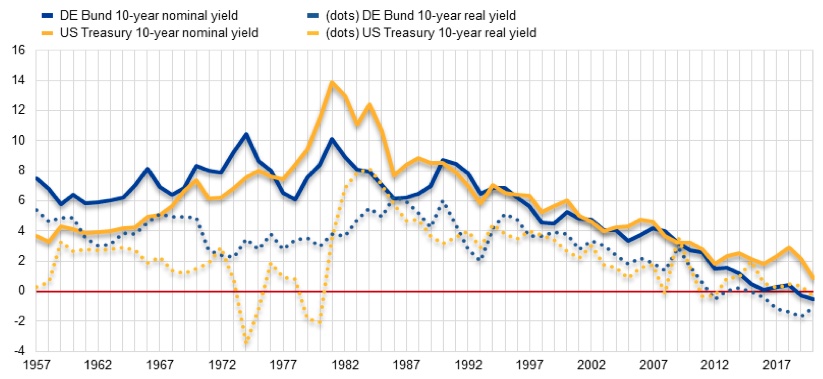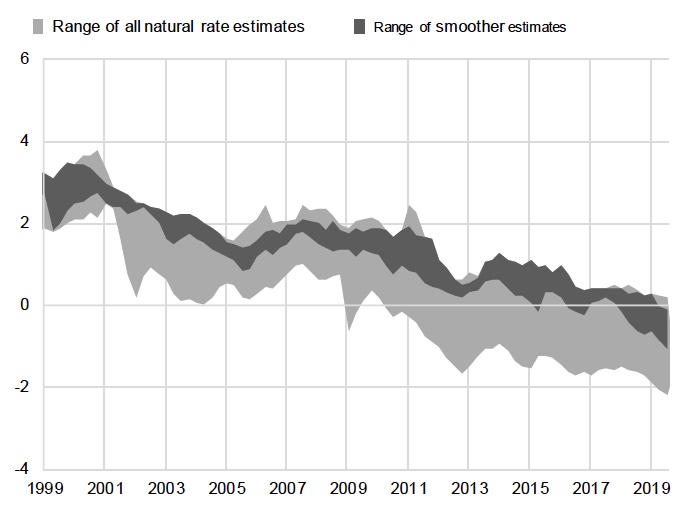At the end of 2019 the European Systemic Risk Board General Board mandated a Task Force on Low Interest Rates to revisit the ESRB’s 2016 report on “Macroprudential policy issues arising from low interest rates and structural changes in the EU financial system”, assess subsequent developments, compare these to the risks identified in the report, and assess whether new sources of systemic risk have emerged.
Furthermore,
the Task Force was mandated to review progress in relation to the policy
proposals in the earlier report, as well as propose possible new policy
actions aimed at mitigating potential systemic risks. As this column
discusses, the new report finds that the low interest rate environment
continues to pose risks for financial stability. For instance, since
2016, search-for-yield behaviour has intensified in the banking and
investment fund sectors, and some business models are proving
unsustainable. To address these sources of risk and vulnerabilities, the
report puts forward a wide range of policy options.
Nominal and real
interest rates in the major advanced economies, short-term and
long-term, have trended downwards since the early 1980s. We see this in
Figures 1 and 2.
Figure 1 Short-term nominal and real interest rates in Germany and the US, 1965-2020 (%)

Source: OECD and ESRB calculations.
Note:
Short-term interest rates are based on three-month money market rates.
Real rates are calculated by subtracting the annual CPI inflation rate.
Figure 2 Nominal and real ten-year government bond yields in Germany and the US, 1957-2020 (%)

Source: OECD and ESRB calculations.
Note:
Yields are based on ten-year constant maturity government bond yields.
Real yields are calculated by subtracting the annual CPI inflation rate.
The ‘natural’ or
‘neutral’ equilibrium real interest rate R* that would support full
employment at stable and low inflation is not directly observable. Many
efforts to estimate it reach similar results, however, as shown for the
euro area in Figure 3.
Figure 3 Estimates of euro area equilibrium real interest rate, Q1 1999 to Q4 2019 (%)

Source: Schnabel (2020).
Notes:
Ranges span point estimates across models to reflect model uncertainty
and no other source or R* uncertainty. The dark shaded area highlights
smoother R* estimates that are statistically less affected by cyclical
movements in the real rate of interest. Latest observation: Q4 2019.
With low and stable
inflation, the decline in R* has forced policy rates down towards their
effective lower bound. This now appears to be somewhat though not much
below zero. Market rates too are very low. Whether policy rates or
market rates, the low interest rate environment (LIRE) has implications
for financial stability and therefore raises issues for macroprudential
policy.
The European
Systemic Risk Board (ESRB), which oversees macroprudential policy in the
EU, has just published a second report discussing macroprudential
policy issues arising from the LIRE in the EU financial system (ESRB
2021). This work began at the end of 2019 and builds on an earlier
report, which the ESRB published in 2016.
The time horizon for
our analysis is medium-term: five to ten years ahead. While the report
acknowledges cross-country heterogeneity, its focus is mainly on the EU
financial system as a whole and on interest rates in the EU.
The report begins with an analysis of how the LIRE has been driven mainly by structural factors, such as:
- demographic
developments including rising life expectancy and falling population
growth rates (Acemoglu and Johnson 2007, Backus et al. 2014, Aksoy et
al. 2019);
- falling (relative)
price of investment goods and the rising share of intangible investment
(Karabarbounis and Neiman 2014, Thwaites 2015);
- slowing pace of technological innovation (Gordon 2016);
- falling marginal product of capital (related to demography and technical progress) (Cochrane 2021);
- rising wealth and income inequality (Summers 2014, Rachel and Summers 2019)
- rising savings
rates in developing countries and the consequent rising demand for
assets issued by advanced economies (Bernanke 2005); and
- evolution of the consumption/wealth ratio (Gourinchas et al. 2020)
This literature
is related to the ‘secular stagnation’ hypothesis revived by Summers in
his speech at the IMF Research Conference in 2013. In addition,
regulatory changes and the more risk-averse positioning adopted by
financial institutions after the global financial crisis (GFC) have
further boosted the demand for safe assets, putting more downward
pressure on real interest rates and on risk premia. Many of these
developments (and the trend decline in R*) hold not just for the euro
area, but also for the US and Japan, and to some extent interest rates
are transmitted globally (the ‘global financial cycle’; see Rey 2013).
Two recent analyses
support ‘low for long’. Kiley (2020) reviews the literature and adds his
own econometric study, concluding: “A range of approaches to estimating
the equilibrium real interest rate confirm a pronounced downward trend
among advanced economies in the level of real short-term interest rates
likely to prevail over the longer term.” Gourinchas et al. (2020) agree:
“Our estimates indicate that short-term real risk-free rates are
expected to remain low or even negative for an extended period of time.”
But what about the
COVID-19 shock? The report acknowledges that contractionary monetary
policies (responding to a temporary rise in inflation) and increases in
term premia (due to a temporary surge of uncertainty) could increase
rates. If they were to occur, we would not expect such effects to be
lasting. As long as the structural factors that have exerted downward
pressure on the natural rate of interest persist, the LIRE will remain
in place, at least in the medium term, according to the report. In fact,
the report’s detailed overview of the effects of the COVID-19 shock
concludes that it may have increased the probability and persistence of a
‘low-for-long’ scenario – so ‘even lower for even longer’.
The risk analysis of the report identifies four key areas of concern in the LIRE:
- the profitability and resilience of banks,
as the LIRE accentuates the negative effects of existing structural
problems in the EU banking sector, including overcapacity and cost
inefficiencies;
- the indebtedness and viability of borrowers, as the LIRE facilitates higher leverage and encourages search-for-yield behaviour;
- systemic liquidity risk, as the LIRE and structural changes have made the financial system more sensitive to market shocks;
- the sustainability of the business models of insurers and pension funds offering longer-term return guarantees, as they experience increasing pressures in the LIRE.
More at Vox
© VoxEU.org
Key

Hover over the blue highlighted
text to view the acronym meaning

Hover
over these icons for more information

Comments:
No Comments for this Article